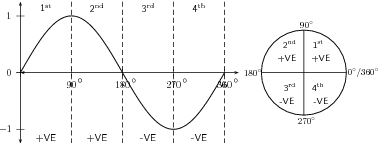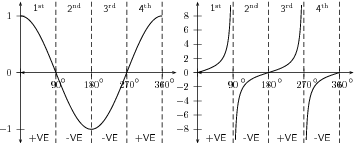| << Chapter < Page | Chapter >> Page > |
This method can be time consuming and inexact. We shall now look at how to solve these problems algebraically.
The first step to finding the trigonometry of any angle is to determine the sign of the ratio for a given angle. We shall do this for the sine function first and then do the same for the cosine and tangent.

In [link] we have split the sine graph into four quadrants , each wide. We call them quadrants because they correspond to the four quadrants of the unit circle. We notice from [link] that the sine graph is positive in the 1 and 2 quadrants and negative in the 3 and 4 . [link] shows similar graphs for cosine and tangent.

All of this can be summed up in two ways. [link] shows which trigonometric functions are positive and which are negative in each quadrant.
| 1 | 2 | 3 | 4 | |
| sin | +VE | +VE | -VE | -VE |
| cos | +VE | -VE | -VE | +VE |
| tan | +VE | -VE | +VE | -VE |
A more convenient way of writing this is to note that all functions are positive in the 1 quadrant, only sine is positive in the 2 , only tangent in the 3 and only cosine in the 4 . We express this using the CAST diagram ( [link] ). This diagram is known as a CAST diagram as the letters, taken anticlockwise from the bottom right, read C-A-S-T. The letter in each quadrant tells us which trigonometric functions are positive in that quadrant. The `A' in the 1 quadrant stands for all (meaning sine, cosine and tangent are all positive in this quadrant). `S', `C' and `T' ,of course, stand for sine, cosine and tangent. The diagram is shown in two forms. The version on the left shows the CAST diagram including the unit circle. This version is useful for equations which lie in large or negative ranges. The simpler version on the right is useful for ranges between and . Another useful diagram shown in [link] gives the formulae to use in each quadrant when solving a trigonometric equation.

Now that we know in which quadrants our solutions lie, we need to know which angles in these quadrants satisfy our equation.
Calculators give us the smallest possible answer (sometimes negative) which satisfies the equation. For example, if we wish to solve we can apply the inverse sine function to both sides of the equation to find:
However, we know that this is just one of infinitely many possible answers. We get the rest of the answers by finding relationships between this small angle, , and answers in other quadrants. To do this we use our small angle as a reference angle . We then look at the sign of the trigonometric function in order to decide in which quadrants we need to work (using the CAST diagram) and add multiples of the period to each, remembering that sine, cosine and tangent are periodic (repeating) functions. To add multiples of the period we use (where is an integer) for sine and cosine and , , for the tangent.

Notification Switch
Would you like to follow the 'Math 1508 (lecture) readings in precalculus' conversation and receive update notifications?